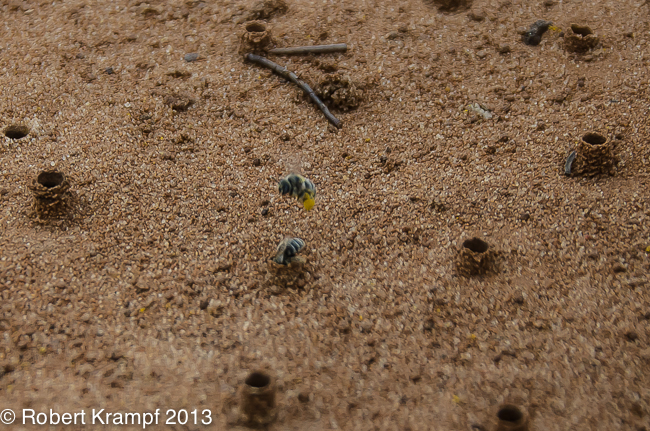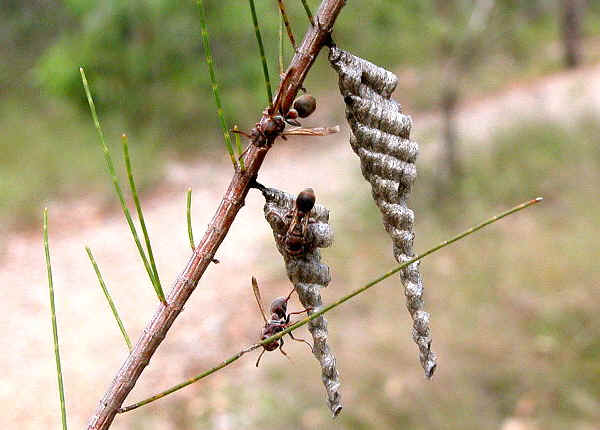Social life history in insects
has evolved multiple times over diverse species and so understandably has a few
different evolutionary paths and some very broad adaptations (Zablotny, 2009). Many solitary
species of bees and wasps have communal nesting, where many females make their
burrows within close quarters to each other but do not provide any provisions
to each other (Gauld & Bolton, 1988). It is not certain whether communal
nesting started to address a need for protection from predators, or due to
adults returning to their birthplaces generation after generation or simply members
of the same species just being mutually attracted to each other (Gauld &
Bolton, 1988). Whatever the reason, this was the first step of socialism in the
hymenoptera.
 |
| Image 1: communal nest site of Cactus Bees (Diadasia australis). |
The different stages of socialism
in insects can be difficult to grasp, so in 1971 the renowned American
biologist E. O. Wilson established a standard vocabulary for describing the
degrees of insect sociality from solitary to eusocial (Zablotny, 2009):
- Solitary species do not have cooperative brood care, reproductive castes or overlapping generations.
- Quasi-social colonies share a nest, cooperate in brood care and also assist each other in providing food, nest building and protection but do not have overlapping generations or reproductive castes.
- Semi-social colonies are those that have some caste structure (a worker caste caring for a reproductive caste) as well as having cooperative brood care.
|
|
| Image 2: semi-social nest of the stick-nest brown paper wasps (Ropalidia revolutionalis) in South East QLD |
- True social colonies are referred to as Eusocial. The generally accepted idea of a eusocial colony in insects is a colony which has cooperative brood care, an overlap of two or more generations & reproductive division of labour or ‘castes’ – in bees the castes are the reproductive queen, the non reproductive female workers and the reproductive male drones.
The haploid-diploid sex
determination system assisted the evolution of social hymenoptera - Sex of
offspring can be determined by the queen and she readjusts the sex ratio to
suit the needs of the colony (Gauld & Bolton, 1988). Large numbers of
female workers can be produced until the need for males arises.
These however are not the only
forms of socialism in the hymenoptera. There is social parasitism where a queen
will take over an already functioning nest (either by killing or living
alongside the original queen of another closely related species, parabiosis
where 2 ant species may utilise the same nests and trails but do not share, lestobiosis
where a smaller and larger species of ant may co-inhabit a nest and others
(Gauld & Bolton, 1988).
I will leave you with a video of Dulosis
or ‘slave-making’ which is common form of socialism in ant species - one species kidnaps pupae of
another species to function as workers in their own nest.
References:
Gauld, I & Bolton, B 1988, The hymenoptera, Oxford University
Press, Oxford.
Zablotny, J 2009, ‘Sociality’, Encyclopedia
of insects. Oxford, United Kingdom: Elsevier Science & Technology, viewed
23 March 2015, Retrieved from <http://search.credoreference.com.elibrary.jcu.edu.au/content/entry/estinsects/sociality/0>
Image 1 – Cactus Bee Nests on The Happy
Scientist, viewed 22 March 2015, <http://thehappyscientist.com/files/DailySciencePhoto/870c.jpg>
Image 2 – Stick-nest Brown Paper Wasp Ropalidia
revolutionalis on Brisbane Insects, viewed 22 March 2015,
<http://www.brisbaneinsects.com/brisbane_vespoidwasps/images/DSC_4461.jpg>
Image 3 – Bee Castes, viewed 22 March
2015,<http://www.brisbaneinsects.com/brisbane_vespoidwasps/images/wpe52.jpg>
Video – ‘Slave raid of P.americanus a obligatory social parasitic ant’,
Youtube, viewed 22 March 2015, <https://www.youtube.com/watch?v=YdzEpd657RU>


Really fascinating. I was curious about the definition of “solitary”. In this definition, it seems to suggest that “solitary” species might still be gregarious, or am I misunderstanding this? I love the idea of animals making “slaves” of each other. Do you know if any mechanisms have evolved in the kidnapped species to recognize it is in the wrong nest? Really interesting reading so far!
ReplyDeleteThe broad spectrum of sociality in the aculeates is very hard to explain in very few words... there are almost evolutionary stepping stones from completely solitary to eusocial. Solitary in this case means they do not have cooperative brood care, no overlapping of generations and as there is only 1 individual, there are no castes - these species therefore have no need or desire to share living quarters but they will inhabit areas close together. These groups that started to live in close quarters are believed to have been put under further pressure from predation or lack of habitat and started to co-inhabit one hive with multiple brood chambers - or communal nesting.
Deleteaccording to D’Ettorre & Heinze (2001) in 'Sociobiology of slave-making ants' in acta ethologica - the evolution of slave raids is still not entirely understood:
"Though slave-making ant species have been studied for more than 150 years, many problems are still open, the most prominent obviously being the evolution of slave raiding itself. Recent investigations have given contradictory results concerning, for example, the mechanisms of chemical integration of slave makers and their hosts in a mixed society, the pattern of sex allocation in slave makers, and coevolution between social parasite and host.".
When do you think eusocial systems first evolved in the Hymenoptera?
ReplyDeleteI know hive building bees and nest building ants were already around in the Cretaceous so eusociality in hymenopterans must go back at least this far and likely further.
As far as I have been able to see, I think you are correct. It seems it was a gradual progression from solitary to eusocial, so socialism must have been present in some form before the emergence of true eusocial species.
ReplyDelete